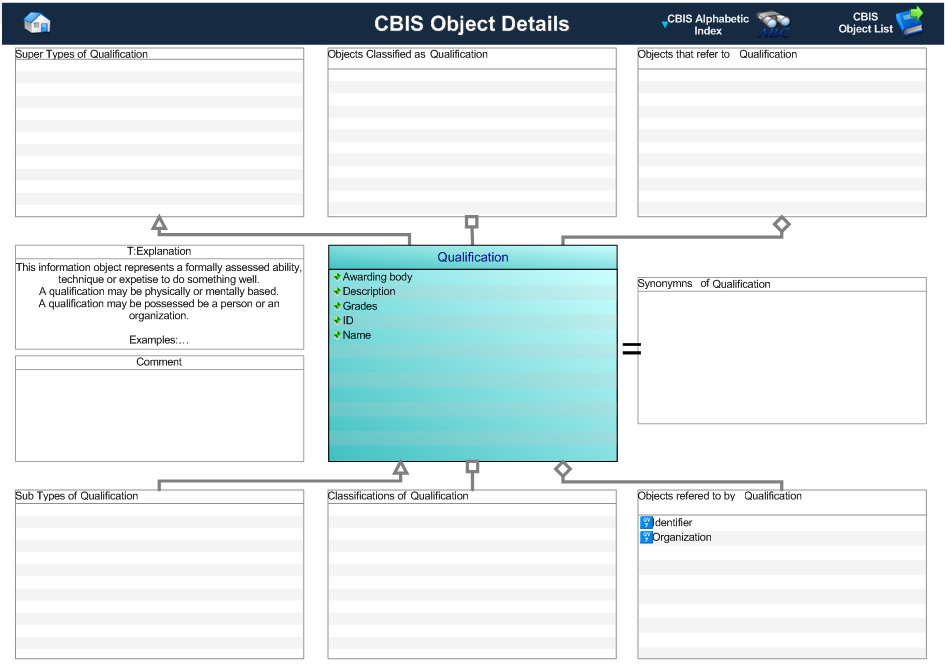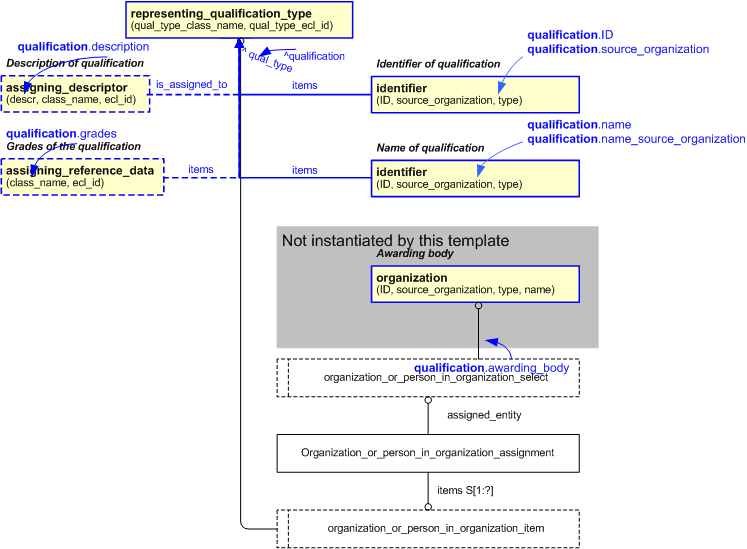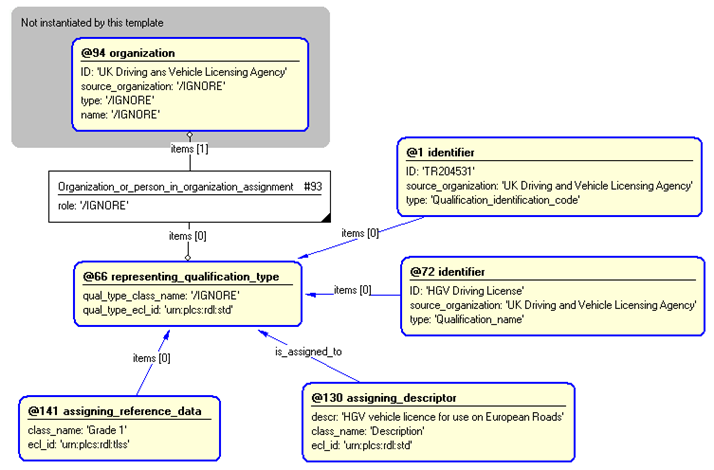Template:— qualification (qual)
Context:— UK_Defence |
Date: 2009/04/17 11:15:01
Revision: 1.3
|
This section specifies the template qualification.
NOTE
The template has been defined in the context of
UK_Defence.
Refer to the business context for details of related templates.
NOTE
An explanation of a template and the associated instantiation path is
provided in the
Template overview
section.
This template describes how to represent a UK_Defence qualification, using
representing_qualification_type.
This represents a formally assessed ability, technique or expertise to do something well.
A qualification may be physically or mentally based.
A qualification may be possessed be a person or an organization.
Examples:
HGV driving licence, GCSE Mathematics, ISO 9001
For further information about the representation of a qualification, see below.
The qualification business object is used by those UK_Defence Data Exchange
Specifications that require information about a formally defined ability,
technique or expertise to do something well.
Figure 1 — Graphical Representation for Business Object qualification
The definition of a qualification object is:
Data about a formally defined ability, technique or expertise to do something well.
|
Attribute name
|
Attribute description
|
Attribute type
|
Optionality
|
| Awarding body |
This is the reference to the organization that awards the qualification.
This may or may not be the same as the organization that has defined the qualification.
|
Organization |
Mandatory |
| Description |
This is the description of the qualification. |
Intrinsic |
Optional |
| Grades |
This is a description of the grades that can be awarded for the qualification. |
Intrinsic |
Optional |
| ID |
This is the identifier of the qualification. |
Identifier |
Mandatory |
| Name |
This is the name of the qualification. |
Intrinsic |
Mandatory |
Table 1 — quallification attribute details
The EXPRESS-G diagram in
Figure
2
shows the templates and EXPRESS entities that are required
to represent the template
"qualification".
The text highlighted in blue shows the template parameters.
Figure 2 — An EXPRESS-G representation of the Information model for qualification
The graphic for the template to be used in other EXPRESS-G diagrams
is shown in Figure
3
below.
Figure 3 — The graphical representation of the qualification template
The following input parameters are defined for this template:
This is the reference to the organization that awards the qualification.
This may or may not be the same as the organization that has defined the qualification.
The description of the qualification.
grade (Type='CLASS', Optional)
This is a description of the grades that can be awarded for the qualification.
The following classes and their sub-classes can be used:
classifications: [Grade]![[warning:]](../../../../../../images/dex/warning.gif) Error RDL4: The URI urn:plcs:rdl:uk_defence is not listed in dexlib/data/refdata/rdl_index.xml
Error RDL4: The URI urn:plcs:rdl:uk_defence is not listed in dexlib/data/refdata/rdl_index.xml
The identifier of the qualification.
The identifier of the organization responsible for identifying the qualification.
The name of the qualification.
The identifier of the organization responsible for naming the qualification.
The following reference parameters are defined for this template:
Allow the
Qualification_type
entity instantiated in this path to be referenced when this template is used.
%^target = $qualification.qualification%
The following parameter combinations specify a uniqueness constraint:
Unique constraint: Unique qualification
Each instance of the
entity
(
Qualification_type)
within the data set shall be uniquely identified
by a combination of the following parameters on this
template (qualification) namely:
ID,
source_organization.
The
instance is
referenced by the following template parameter:
qualification.
Any given identifier shall only be assigned to a qualification once.
The instantiation path shown below specifies the entities that are to be
instantiated by the template.
A description of templates and the syntax for the instantiation path is
provided in the
Templates Help/Information section.
/
representing_qualification_type(
qual_type_class_name='/IGNORE',
qual_type_ecl_id='urn:plcs:rdl:std')/
%^qualification = $representing_qualification_type.qual_type%
-- [optional Description] /
assigning_descriptor(
descr=@description,
class_name='Description',
ecl_id='urn:plcs:rdl:uk_defence',
is_assigned_to=^qualification)/
-- [optional Grade] /
assigning_reference_data(
items=^qualification,
class_name=@grade,
ecl_id='urn:plcs:rdl:uk_defence')/
/
identifier(
ID=@ID,
source_organization=@source_organization,
type='Qualification_identification_code',
items=^qualification)/
/
identifier(
ID=@name,
source_organization=@name_source_organization,
type='Qualification_name',
items=^qualification)/
-- Instantiate Organization_or_person_in_organization_assignment entity Organization_or_person_in_organization_assignment-- Set the Organization_or_person_in_organization_assignment attribute role to be ignored Organization_or_person_in_organization_assignment.role = '/IGNORE'
-- Assign the Organization_or_person_in_organization_assignment to the qualification Organization_or_person_in_organization_assignment.items ->
^qualification
-- Create the owned_by parameter Organization_or_person_in_organization_assignment.assigned_entity ->
@awarding_body
The following entities are instantiated with attributes as specified:
The instance diagram in Figure
4
shows an example of the EXPRESS entities and templates that are instantiated by the template:
/qualification(awarding_body='UK Driving and Vehicle Licensing Agency', ID='TR204531', source_organization='UK Driving and Vehicle Licensing Agency', name='HGV Driving licence', name_source_organization='UK Driving and Vehicle Licensing Agency', descr='HGV vehicle licence for use on European Roads', grade='Grade 1')/
(an illustration of the consolidated qualification template is shown in
Figure
5 below.)
Figure 4 — Entities instantiated by qualification template
The instance diagram in
Figure
5
shows the graphic symbol for the template that is to be
used in other instance diagrams. The example template is:
/qualification(awarding_body='UK Driving and Vehicle Licensing Agency', ID='TR204531', source_organization='UK Driving and Vehicle Licensing Agency', name='HGV Driving licence', name_source_organization='UK Driving and Vehicle Licensing Agency', descr='HGV vehicle licence for use on European Roads', grade='Grade 1')/
Figure 5 — Instantiation of qualification template
Characterizations
No common characterizations of the template
qualification
have been identified. However, the ISO 10303-239 EXPRESS model
may enable other assignments to the entities instantiated by the template.




